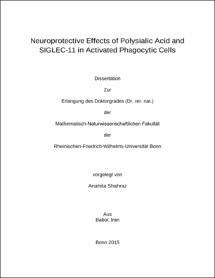Neuroprotective Effects of Polysialic Acid and SIGLEC-11 in Activated Phagocytic Cells

Neuroprotective Effects of Polysialic Acid and SIGLEC-11 in Activated Phagocytic Cells

| dc.contributor.advisor | Neumann, Harald | |
| dc.contributor.author | Shahraz, Anahita | |
| dc.date.accessioned | 2020-04-22T00:09:49Z | |
| dc.date.available | 2020-04-22T00:09:49Z | |
| dc.date.issued | 30.03.2016 | |
| dc.identifier.uri | https://hdl.handle.net/20.500.11811/6731 | |
| dc.description.abstract | SIGLEC-11 is an inhibitory receptor expressed on microglial cells and macrophages and can recognize α 2→8 linked Sias structures. The surface of neuron is decorated by different lengths of polySias. PolySia-SIGLEC-11 interaction is important to keep normal physiological conditions in neuron-microglia co-culture systems. However, till now it was not clear which length of polySia is recognized by SIGLEC-11. In this study the low molecular weight polySia with average degree of polymerization 20 (polySia avDP20), among different polySia lengths, introduced as the best length which was recognized by SIGLEC-11. PolySia avDP20 pre-treatment upon Aβ or debris stimulation kept superoxide release of microglia/macrophages as low as of untreated cells. This effect was not observed when cells were pre-treated with monoSia or oligoSias. Furthermore, compared to other polySia lengths (avDP60 and avDP180), polySia avDP20 had no effect on the metabolic activity of cells. Knockdown of SIGLEC-11 was enough to prevent the inhibitory function of polySia avDP20. Additional experiments showed that the anti-superoxide effect of polySia avDP20 was as potent as Trolox and SOD1. Phagocytosis analysis in iPSdM cells and macrophages revealed that polySia avDP20 pre-treatment did reduce uptake of Aβ and debris, which are inflammatory phagocytosis stimulants. Neurons were differentiated from pNSCs to investigate the consequence of polySia avDP20 addition to co-cultures with iPSdM/macrophages. Co-culture of Aβ or LPS stimulated iPSdM/macrophage with neurons led to shorter neurite length. This length could stay like untreated neurons if polySia avDP20 was present. Thus, this study suggests polySia avDP20 as a ligand for SIGLEC-11 receptor to reduce the inflammatory response of phagocytes towards provoking stimulants. | en |
| dc.language.iso | eng | |
| dc.rights | In Copyright | |
| dc.rights.uri | http://rightsstatements.org/vocab/InC/1.0/ | |
| dc.subject.ddc | 500 Naturwissenschaften | |
| dc.subject.ddc | 570 Biowissenschaften, Biologie | |
| dc.subject.ddc | 610 Medizin, Gesundheit | |
| dc.title | Neuroprotective Effects of Polysialic Acid and SIGLEC-11 in Activated Phagocytic Cells | |
| dc.type | Dissertation oder Habilitation | |
| dc.publisher.name | Universitäts- und Landesbibliothek Bonn | |
| dc.publisher.location | Bonn | |
| dc.rights.accessRights | openAccess | |
| dc.identifier.urn | https://nbn-resolving.org/urn:nbn:de:hbz:5n-43063 | |
| ulbbn.pubtype | Erstveröffentlichung | |
| ulbbnediss.affiliation.name | Rheinische Friedrich-Wilhelms-Universität Bonn | |
| ulbbnediss.affiliation.location | Bonn | |
| ulbbnediss.thesis.level | Dissertation | |
| ulbbnediss.dissID | 4306 | |
| ulbbnediss.date.accepted | 01.03.2016 | |
| ulbbnediss.institute | Medizinische Fakultät / Institute : Institut für Rekonstruktive Neurobiologie (IRN) | |
| ulbbnediss.fakultaet | Mathematisch-Naturwissenschaftliche Fakultät | |
| dc.contributor.coReferee | Burgdorf, Sven |
Dateien zu dieser Ressource
Das Dokument erscheint in:
-
E-Dissertationen (4382)




